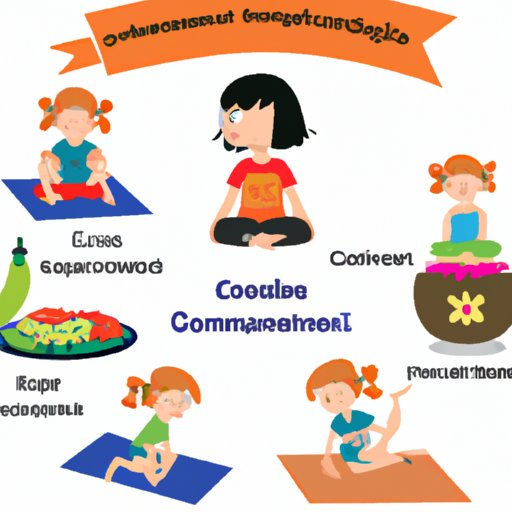
I. Introduction
Childhood constipation is a common problem that affects many children, and it can be uncomfortable and even painful if left untreated. As a parent or caregiver, being aware of effective and natural remedies can help relieve this issue and prevent it from recurring. This article will cover five natural remedies for childhood constipation, gentle yoga poses to stimulate bowel movements, foods that help relieve constipation, behavioral changes to improve digestive health, and when to seek medical help.
II. Five Natural Remedies for Childhood Constipation
Dietary fiber plays a crucial role in regulating bowel movements, preventing constipation, and promoting optimal digestive health. Here are five natural remedies to relieve child constipation:
- Increase the intake of fruits, vegetables, and whole-grain foods that are high in fiber.
- Incorporate more physical activity and exercise into the child’s routine, such as running, playing, or cycling.
- Add natural laxatives to the child’s diet such as prunes, plum juice or raw honey.
- Ensure the child is drinking enough water and staying hydrated, especially in hot weather.
- Try natural home remedies, such as massage gums, belly message, or warm water bath or shower..
It is important to understand that while these remedies are generally safe, certain precautions should be taken, such as monitoring the child’s fluid intake and being mindful of any allergic reactions. Always consult a pediatrician before trying any new remedy.
III. Gentle Yoga Poses to Relieve Child Constipation
Yoga can be a gentle and effective way to stimulate bowel movements in children, reduce stress, and promote relaxation. Here are a few yoga poses that can help:
- The seated forward bend
- The wind-relieving pose
- The child’s pose
For each pose, have the child sit on a yoga mat and follow step-by-step instructions and illustrations to ensure correct alignment and proper form. It is important to also remember that the child should always practice yoga under the guidance of a certified instructor.
IV. Foods That Help Relieve Constipation in Kids
A balanced diet that consists of plenty of fruits, vegetables, and whole grains is crucial for relieving constipation in children. The following foods are high in fiber and can help promote regular bowel movements:
- Prunes, plums and raisins
- Apples, pears, and berries
- Beans, lentils, and chickpeas
- Whole-grain bread, pasta, and cereals
- Nuts and seeds such as chia seeds and flax seeds
Parents can incorporate these foods into their child’s diet through creative meal planning and recipe ideas. For example, try adding a handful of berries to the child’s breakfast cereal or making a bean and vegetable soup for lunch. Remember to limit processed foods high in sugar and unhealthy fats.
V. How Behavioral Changes Can Improve Child Constipation
Daily routines and habits can have an impact on digestive health and reduce instances of constipation. A few changes that can help include:
- Establishing a regular bathroom routine, such as having the child sit on the toilet for a few minutes each day after meals.
- Encouraging hydration by offering water, herbal tea, or diluted fruit juices.
- Reducing stress through relaxation techniques like deep breathing, visualization, and mindfulness activities.
It is important to be patient and consistent with these changes, and make them a part of the child’s daily routine. Parents can lead by example and practice these habits themselves.
VI. When to Seek Medical Help for Child Constipation
In some cases, constipation may require medical attention. If the child experiences any of the following symptoms, medical help may be needed:
- Painful bowel movements with bleeding
- Persistent constipation that does not respond to natural remedies for several weeks
- Abdominal pain, bloating, or swelling that lasts more than a few days
- Vomiting or fever
- Other underlying medical conditions that may contribute to the child’s constipation, such as thyroid disorders or medication side effects.
If any of these symptoms occur, it is best to visit a pediatrician or primary care doctor, who can conduct a physical examination, order tests, and recommend appropriate treatment options.
VII. Conclusion
Relieving constipation in children naturally can improve their overall health, prevent discomfort, and reduce the need for medical intervention. Incorporating a balanced diet with fiber-rich foods, physical activity, yoga poses, and small behavioral changes can make a significant difference. If natural remedies do not work, seeking medical help is a crucial step to ensure that the underlying cause of constipation is properly diagnosed and treated. With these tips and remedies, parents and caregivers can promote healthy bowels and digestive function in their children.




